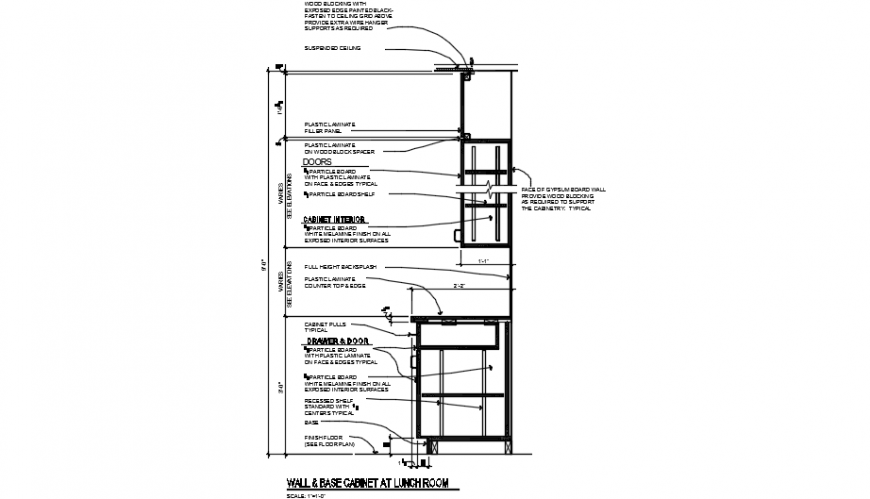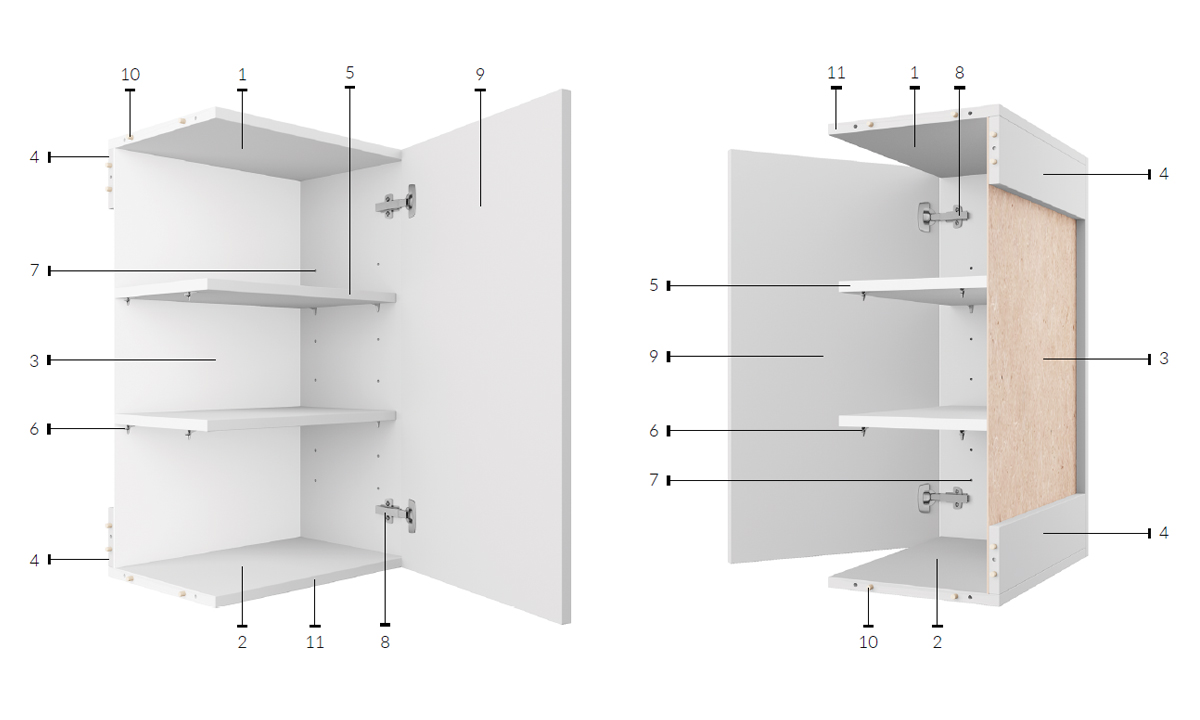Benefits of Built-In Wall Cabinets: Built In Wall Cabinets
:max_bytes(150000):strip_icc()/how-to-build-cabinets-3537068_1_final-5c6599d0c9e77c0001d43160.png)
Built-in wall cabinets offer a unique blend of functionality and aesthetics, providing a distinct advantage over freestanding cabinets. They seamlessly integrate with your space, maximizing storage potential while adding a touch of elegance.
Enhancement of Functionality and Aesthetics
Built-in wall cabinets are designed to optimize space utilization. They eliminate the need for bulky freestanding units, creating a streamlined and clutter-free environment. The customizability of built-in cabinets allows you to tailor them to your specific needs, maximizing storage capacity and accessibility. For instance, you can incorporate features like pull-out shelves, spice racks, or integrated lighting to enhance functionality. Furthermore, the seamless integration of built-in cabinets with the existing architecture adds a sophisticated touch to any room, creating a cohesive and polished aesthetic.
Examples of Rooms Where Built-In Wall Cabinets are Beneficial
Built-in wall cabinets are particularly beneficial in various rooms, including:
- Kitchen: Built-in cabinets maximize storage space, keeping countertops clutter-free. They can accommodate appliances, pantry items, and even serve as a stylish backdrop for a breakfast bar.
- Bathroom: Built-in cabinets create a sleek and organized bathroom environment, offering ample storage for toiletries, towels, and linen. They can also be designed to house a vanity sink or even a small shower enclosure.
- Bedroom: Built-in cabinets offer a solution for maximizing storage in a bedroom, creating a streamlined and organized look. They can be designed to include drawers, shelves, and even a dedicated space for a television or sound system.
- Living Room: Built-in cabinets provide a stylish and functional way to organize media equipment, books, and decorative items. They can also be used to create a dedicated home office space or a cozy reading nook.
- Home Office: Built-in cabinets provide a dedicated and organized workspace. They can include shelves for books and files, drawers for stationery and office supplies, and a desk area for work.
Potential Cost Savings
While the initial cost of installing built-in cabinets might seem higher than freestanding units, the long-term cost savings can be significant.
- Increased Resale Value: Built-in cabinets add value to a home, making it more appealing to potential buyers. This can result in a higher resale price when you decide to sell your property.
- Reduced Need for Additional Furniture: Built-in cabinets eliminate the need for freestanding furniture, like bookshelves or dressers, resulting in cost savings. This also reduces clutter and maximizes floor space.
- Long-Term Durability: Built-in cabinets are typically made from high-quality materials and are designed to last for years. This reduces the need for frequent replacements, saving you money in the long run.
Planning and Design Considerations

Built-in wall cabinets offer a unique blend of functionality and aesthetics, transforming your space into a well-organized and stylish haven. To ensure your project aligns with your vision and needs, careful planning and design are crucial.
Measuring and Assessing Space
Accurately measuring the available space is the foundation of any successful built-in cabinet project. Start by meticulously measuring the width, height, and depth of the area where you plan to install the cabinets. Consider any existing features, such as windows, doors, or electrical outlets, that may affect the placement and dimensions of the cabinets.
- Take multiple measurements to ensure accuracy and avoid potential errors.
- Draw a scaled floor plan to visualize the layout and dimensions of the cabinets within the space.
- Factor in the thickness of the cabinet materials when calculating the overall dimensions.
- Leave sufficient clearance around the cabinets for easy access and movement.
Choosing Materials and Finishes
The materials and finishes you select for your built-in cabinets will significantly impact their durability, aesthetics, and overall cost. Consider factors such as your budget, desired style, and the specific use of the cabinets.
- Cabinet boxes are typically made from plywood, MDF, or solid wood. Plywood is a popular choice for its strength and affordability, while MDF offers a smooth, consistent surface. Solid wood is the most expensive option but provides a unique and elegant look.
- Cabinet doors and drawer fronts can be made from various materials, including wood, glass, metal, or acrylic. The choice depends on your personal preferences and the overall design of the cabinets.
- Finishes include paint, stain, or veneer. Paint offers a wide range of color options and is easy to maintain. Stain enhances the natural grain of wood, while veneer provides the look of solid wood at a lower cost.
Cabinet Styles
The style of your built-in cabinets should complement the overall design of your room. Here’s a table showcasing various cabinet styles and their suitability for different rooms:
| Cabinet Style | Description | Suitable for |
|---|---|---|
| Traditional | Features ornate details, such as raised panels, moldings, and decorative hardware. | Formal dining rooms, living rooms, and libraries. |
| Contemporary | Clean lines, minimalist details, and sleek finishes. | Modern kitchens, bathrooms, and home offices. |
| Rustic | Natural wood finishes, distressed textures, and hardware with a vintage look. | Country kitchens, living rooms, and bedrooms. |
| Industrial | Metal accents, exposed hardware, and reclaimed wood. | Loft apartments, kitchens, and home offices. |
Installation and Customization

Installing built-in wall cabinets requires careful planning and execution, but the rewards are well worth the effort. From the initial measurements to the final touches, the process involves several steps, and understanding these steps can help you achieve the desired results.
Installation Process
The installation process typically involves these steps:
- Planning and Design: This involves determining the layout, cabinet sizes, and desired features. It’s essential to consider the existing wall structure, electrical outlets, and plumbing lines.
- Cabinet Construction: The cabinets can be constructed on-site or pre-fabricated. Pre-fabricated cabinets offer convenience, while on-site construction allows for greater customization.
- Wall Preparation: The walls need to be properly prepared to support the weight of the cabinets. This may involve reinforcing the walls with studs or adding additional support.
- Cabinet Installation: The cabinets are secured to the wall using screws or brackets. The process involves aligning the cabinets, ensuring level placement, and securing them firmly.
- Finishing Touches: This includes adding trim, doors, hardware, and any other desired features. It’s important to choose finishes that complement the existing décor.
Cabinet Construction Methods
Cabinet construction methods can significantly impact the overall look, functionality, and cost of your built-in wall cabinets. Two common methods are:
- Framed Cabinets: Framed cabinets feature a traditional construction with face frames that provide structural support and a finished look. They are often more affordable and readily available.
- Frameless Cabinets: Frameless cabinets are more contemporary in design, with no face frames. They offer a sleek, minimalist look and maximize interior space. They are generally more expensive than framed cabinets.
Incorporating Unique Features
Built-in wall cabinets offer a blank canvas for creativity. You can incorporate unique features to enhance functionality and aesthetics.
- Integrated Lighting: Recessed LED lighting can illuminate the interior of the cabinets, creating a stylish and functional feature.
- Pull-Out Shelves: These shelves provide easy access to items stored in the back of the cabinet.
- Spice Racks: These are great for organizing spices and maximizing space in smaller cabinets.
- Wine Racks: These can be incorporated into cabinets for storing and displaying wine bottles.
Customizing Cabinet Designs, Built in wall cabinets
Customizing cabinet designs allows you to tailor the storage solution to your specific needs.
- Cabinet Depth: Adjusting the depth of the cabinets can accommodate larger items or create a more streamlined look.
- Cabinet Height: The height of the cabinets can be adjusted to fit the available space and create a cohesive look with the rest of the kitchen or bathroom.
- Door Styles: Different door styles, such as shaker, raised panel, or flush, can complement the overall design of the room.
- Hardware: Hardware options, such as handles, knobs, and hinges, can add a finishing touch and reflect personal style.
Built in wall cabinets – Built-in wall cabinets provide a clean and efficient storage solution, adding a touch of elegance to any room. Their functionality is further enhanced when paired with a classic design, such as formica countertops with oak cabinets. This combination creates a harmonious blend of practicality and style, allowing for both ample storage and a visually appealing space.
With built-in wall cabinets, organization and aesthetic appeal go hand in hand.
Built-in wall cabinets offer a clean and efficient way to maximize storage space, especially in smaller kitchens. Their sleek design can also enhance the overall aesthetic of a room. To further elevate the functionality and visual appeal of these cabinets, consider incorporating brilliant evolution under cabinet lights.
These lights provide ample task lighting, making it easier to work in the kitchen, while also adding a touch of modern sophistication. The combination of built-in wall cabinets and under-cabinet lighting creates a harmonious blend of practicality and style.